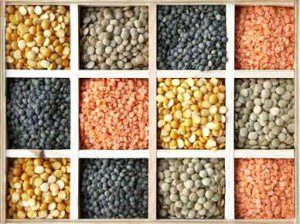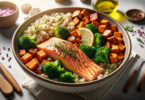Every few months, it seems, there’s hype about the latest, hottest superfood—chia seeds and acai berries spring to mind. And while I’m always interested in trying new foods (especially ones that are healthy for me), as a registered dietitian and associate nutrition editor of Eating Well Magazine, I have to remember that LOTS of foods, many of which are stocked in nearly every grocery store in America, are “superfoods.”
The added bonus to eating more of these easy-to-find super-healthy foods? They won’t break the bank. In fact, I’ve rounded up 12 of my favorite healthy foods that each clock in at under a dollar per serving.
*These are average prices gathered from online grocery stores and a USDA 2011 survey of fruit and vegetable prices. Although the cost of these foods may differ from store to store, these are all healthy foods that are generally a good value relative to the nutrition they provide.
—Kerri-Ann Jennings, M.S., R.D., Associate Nutrition Editor
1. Lentils
Cost Per Serving (1 cup): 15 ¢
Why lentils are so good for you: Like beans, lentils are high in fiber and protein (8 grams and 9 grams per half cup, respectively), which makes them great for your heart. They have the edge over beans, though, when it comes to preparation. Lentils cook up in only 15 to 30 minutes and don’t need to be presoaked.
2. Oats
Cost Per Serving (1/3 cup, uncooked): 10 ¢
Why oats are so good for you: Oats are a great way to get soluble fiber in your diet (they deliver 3 grams per serving). Research suggests that increasing your intake of soluble fiber by 5 to 10 grams each day could result in a 5 percent drop in “bad” LDL cholesterol. Plus, the quick-cooking oats are just as healthy as steel-cut—just steer clear of oatmeal packets that are loaded with added sugars.
3. Kale
Cost Per Serving (1 cup): 60 ¢
Why kale is so good for you: Kale is an undisputed superfood. A single serving (1 cup cooked) has 10 times the daily value of bone-healthy vitamin K. It also has 3 times the daily value of vitamin A and is high in lutein and zeaxanthin, which all help your vision. Plus, it’s pretty darn tasty.
4. Almonds
Cost Per Serving (1 oz.): 63 ¢
Why almonds are so good for you: A 1-ounce serving (23 nuts, 162 calories) has 37 percent of your daily value for vitamin E—a nutrient many Americans fall short on. Almonds also deliver some calcium, fiber and folate. Not only that, a serving of almonds has as many flavonoids as a cup of green tea, according to a study in the Journal of Agricultural and Food Chemistry.
5. Tea
Cost Per Serving (1 tea bag): 10 ¢
Why tea is so good for you: While we’re on the subject of tea, there’s no doubt it’s a super-healthy, budget-friendly addition to your diet. Tea, especially green tea, has lots of health boons. Both green and black tea are loaded with antioxidants, which may boost your immune system and promote heart health. In fact, scientists have found that those who drink 12 ounces or more of tea a day were about half as likely to have a heart attack as non-tea drinkers.
6. Oranges
Cost Per Serving (1 orange): 34 ¢
Why oranges are so good for you: You can get your entire day’s worth of vitamin C in a single orange. Plus, oranges deliver fiber (3 grams in one orange) and water to keep you full for only 70 calories. Not only that, the orange color means it delivers vision-boosting beta carotene.
7. Tuna
Cost Per Serving (3 oz.): 48-77 ¢
Why tuna is so good for you: Sure, salmon gets a glowing (and well-deserved) rep for being a megasource of omega-3s. But did you know that lowly canned tuna also delivers omega-3s? Plus, the 2010 Dietary Guidelines recommend cutting back on meat—eating tuna up to twice a week is one way to do that. Look for chunk light tuna, which comes from smaller tuna fish and is lower in mercury than white albacore tuna.
8. Peanut Butter
Cost Per Serving (2 tbsp.): 21 ¢
Why peanut butter is so good for you: Don’t knock peanut butter. Not only is it delicious and versatile, it delivers many of the same benefits as more expensive tree nuts, such as improving cholesterol and lowering risk of heart disease. Peanut butter delivers heart-healthy mono- and polyunsaturated fats, vitamin E and zinc. Look for natural peanut butter (a brand that has just peanuts—and salt, if you insist—as the ingredients) to avoid partially hydrogenated oils and sugar.
9. Apples
Cost Per Serving (1 apple): 28 ¢
Why apples are so good for you: Apples don’t have megadoses of any one vitamin or mineral to boast about (although they have some vitamin C), but several research studies suggest that apples have tangible benefits for your heart. The latest one, out of Florida State University, showed that people who ate the equivalent of 2 apples daily for a year improved these markers. Researchers think it’s a combination of the pectin (a type of fiber)and polyphenols that makes apples so good for you.
10. Eggs
Cost Per Serving (1 egg): 17 ¢
Why eggs are so good for you: For such a small and inexpensive food, eggs pack in a lot of nutrition. The whites are brimming with protein (4 grams per egg), while the yolks deliver some vitamin D plus a lutein and xeanthanin, which lowers the risk of age-related macular degeneration—a disease that affects one in eight Americans with vision loss and sometimes blindness. All that for 80 calories. (There’s a reason they’re touted as the “incredible, edible egg”.)
11. Carrots
Cost Per Serving (1 cup): 32 ¢
Why carrots are so good for you: Sweet potatoes get a lot of love for being a superfood, but so should the carrot. After all, they’re both orange, which means they both deliver beta-carotene (a type of vitamin A). A cup of carrots actually delivers 4 times the DV of vitamin A, which helps build bone and contributes to immune function.
12. Cabbage
Cost per serving (1 cup): 27 ¢
Why cabbage is so good for you: Like kale, cabbage is a cruciferous vegetable and diets rich in cruciferous vegetables are linked to lower rates of cancer. It’s also is an excellent source of vitamins C and K, and delivers fiber and detoxifying sulfur compounds. Red cabbage also boasts anthocyanins, an antioxidant thought to keep your heart healthy and brain sharp. Plus it’s very low in calories (22 per cup).
Source – eatingwell.com

If you've found value in our articles, we invite you to support the release of our brand-new book, "Gratitude Practices for Kids: A Practical Guide for Adults to Instill a Spirit of Appreciation and Positivity in the Next Generation."
"Gratitude Practices for Kids" brings together over 25 innovative and accessible practices designed to enhance gratitude in everyday life. This comprehensive guide is backed by 17 scientific studies, ensuring each concept is grounded in research, underscoring our commitment to nurturing growth, emotional intelligence, and positive interactions between adults and children.
We encourage you to opt for the paperback version to celebrate this new release. Dive into its fresh pages away from digital distractions, allowing you to immerse yourself in the transformative practices it offers.
Over recent years, Wake Up World has faced significant online censorship, which has impacted our financial ability to operate. Moving into book publishing represents a strategic step to secure the ongoing funds needed to continue our mission. By purchasing Gratitude for Kids, you help us keep our content free and accessible to everyone, avoiding needing a paywall. With over 8,500 articles published in the last 13 years, we remain dedicated to keeping our valuable content open to all.








